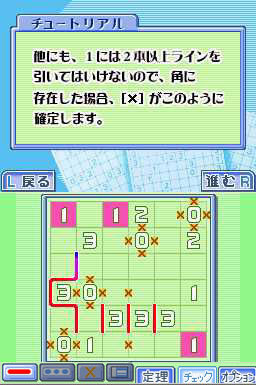
Throw that newspaper away. Forget seven across on the cryptic crossword. Ignore the last column of the sudoku. There's a new, quirky yet logical Japanese puzzle to be solved, and it doesn't require you to scribble down numbers while trying to choose between a stab in the dark and a wild guess.
Slitherlink is its name, and all it asks you to do is think.
Looking at the Slitherlink screenshots, you might be forgiven for being a bit confused. Certainly the person who's tried to reinvent it on the back page of The Daily Telegraph really hasn't got their head around the concept. But give Slitherlink half an hour of your time, and you'll understand it's much more than some dots and numbers.
Far from being a poor-man's number puzzle, Slitherlink surpasses sudoku in depth and pure puzzliness. And, in the case of this game, the fifth release (Japanese only, so far) in Hudson's generic puzzle series, it's also been brilliantly designed for the DS hardware.
Trying to explain exactly how best to play Slitherlink is a little like giving a crash course in open-heart surgery (check out PG Tips below for our attempt). Still, like all great puzzles, and notably unlike open-heart surgery, the basics are simple enough.
You're presented with a grid of dots, some of which contain the numbers zero, one, two or three. All you need to do is draw a single loop through some of those dots in such a manner that each of those the numbers are fenced in on as many sides as their numerical value demands.
For instance, a four dot square containing a '1' should have exactly two of its four dots joined together, filing in one side of the square, as indicated by the '1'.
What makes Slitherlink harder is the loop you draw across the entire puzzle must consist of a single, continuous line – it can't cross or split – and you have to satisfy the above condition for every number on the grid.
Generally, that's fairly easy for say, six by six grids. But when you move into the big, double-figure leagues (the kind of grids that make an Excel spreadsheet blush), you're faced with a mind-bending kind of challenge. That's when Slitherlink stops being a coffee-break puzzle, and starts to take your brain for a ride.
At first, you'll simply fall back on the 'rules' for placing lines (the good old zero with a neighbouring three is a personal favourite) and progress will probably be pretty slow. But as the difficulty increases, you'll feel yourself becoming much better at the game, and not just in terms of how quickly you can spot those provided rules, but in how you begin to sharpen your own pattern recognition skills.
More so than any other puzzler, and perhaps even more than any other DS brain game, Slitherlink makes you feel like you're getting cleverer, and that makes it a joy to complete each puzzle.
Inevitably perhaps, Slitherlink has some problems. The most noticeable is it's in Japanese. (As yet there's no news on whether an English language version will be released, so you'll need to go to an importer. Elsewhere, US publisher Agetec is apparently releasing a version as part of its DS Puzzle Collection.)
Still, it's relatively simple to get past the language barrier once you get started. In general, experimentation gets you where you need to be, and there's very little you can break in Slitherlink.
Slitherlink is also demanding of your touchscreen. Sloppily calibrated screens will have you tearing your hair out as you try to place those last few lines against the clock, so make sure your DS is freshly calibrated.
You'll let the game off most misdirected lines though. That's because Slitherlink has the curious power to calm you down. Maybe it's the fact it requires you to strip out any mental activities not dedicated to problem-solving, or maybe it's just the bleepy electronic music that soothes the subconscious.
It's also because Slitherlink is so well thought-out. As the puzzles get larger, the top screen shows you a map of the entire puzzle, while the touchscreen zooms in, enabling you to scroll around and place your lines. It's a very comfortable way of playing, and the graphics don't have any flashy extras (except for the rainbow that shoots up and down the lines you draw), resulting in a clean interface dedicated to the puzzle.
Overall, the combination of this fresh new concept and the DS hardware provides a hugely enjoyable experience, despite it being in a foreign language. Sayonara sudoku.
Slitherlink

